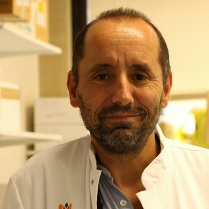Idiopathic Pulmonary Fibrosis: Pathogenic Pathways and Treatment Strategies
A special issue of Cells (ISSN 2073-4409). This special issue belongs to the section "Tissues and Organs".
Deadline for manuscript submissions: 31 October 2024 | Viewed by 12696
Special Issue Editors
Interests: Pulmonary fibrosis, protease activated receptors (PARs), pulmonary inflammation, epithelial to mesencymal transition (EMT), blood coagulation, animal models, in vitro models, cell cultures, alveolar epithelial cells, smooth muscle cells, endothelial cells, fibroblasts, macrophages, pro-inflammatory and fibroproliferative cytokines and growth factors, proliferation, migration, transcription factors and biomarkers
Interests: Pulmonary fibrosis, protease activated receptors (PARs), pulmonary inflammation, epithelial to mesencymal transition (EMT), blood coagulation, animal models, in vitro models, cell cultures, alveolar epithelial cells, smooth muscle cells, endothelial cells, fibroblasts, macrophages, pro-inflammatory and fibroproliferative cytokines and growth factors, proliferation, migration, transcription factors and biomarkers
Special Issue Information
Dear Colleagues,
Idiopathic pulmonary fibrosis (IPF), the most common form of pulmonary fibrosis (PF), is a chronic and ultimately fatal disease characterized by a progressive decline in lung function. The prognosis of IPF is devastating, especially given that the median survival time lies between 3 and 5 years after diagnosis. Furthermore, only 15% of patients suffering from the disease show survival up to 10 years from the onset of symptoms, and the mortality rate of IPF exceeds many types of cancer. Despite the US Food and Drug Administration approval of nintedanib and pirfenidone for the treatment of IPF, pharmacological treatment options remain limited for IPF. Both drugs reduce the decline in lung function and (modestly) improve the survival of IPF patients but they have serious side effects, show no benefit on the quality of life, and do not stop nor reverse the disease. Additional therapies to improve the prognosis and quality of life of IPF patients are, therefore, urgently needed. The pathogenesis of IPF is complex and only partly understood. According to the current paradigm, IPF results from a failure in alveolar epithelial regeneration and an aberrant wound-healing response following repetitive epithelial injury. Once initiated, epithelial injury leads to immune cell infiltration and fibroblast activation, leading to extracellular matrix deposition within the alveolar interstitium and consequent destruction of the alveolar architecture. Detailed knowledge on cellular and molecular processes underlying the initiation and progression of IPF remains elusive, however, and a better understanding of pathogenic processes driving disease progression is essential in order to identify alternative therapeutic targets and improve the quality of life among IPF patients.
The aim of this Special Issue, entitled “Idiopathic Pulmonary Fibrosis: pathogenic pathways and treatment strategies”, is to provide a detailed and up-to-date overview of IPF. We welcome both original papers and comprehensive reviews which cover important developments in the pathogenesis of IPF, as well as treatment strategies that hold promise for this dismal disease. In addition, we welcome papers on (novel) experimental models that accurately reflect disease progression in patients in order to improve the translation of basic scientific work into clinical efficacy.
We look forward to receiving your contributions. Dr JanWillem Duitman and Dr C. Arnold SpekGuest Editors.
Dr. Christoffel Arnold Spek
Dr. Jan Willem Duitman
Guest Editors
Manuscript Submission Information
Manuscripts should be submitted online at www.mdpi.com by registering and logging in to this website. Once you are registered, click here to go to the submission form. Manuscripts can be submitted until the deadline. All submissions that pass pre-check are peer-reviewed. Accepted papers will be published continuously in the journal (as soon as accepted) and will be listed together on the special issue website. Research articles, review articles as well as short communications are invited. For planned papers, a title and short abstract (about 100 words) can be sent to the Editorial Office for announcement on this website.
Submitted manuscripts should not have been published previously, nor be under consideration for publication elsewhere (except conference proceedings papers). All manuscripts are thoroughly refereed through a single-blind peer-review process. A guide for authors and other relevant information for submission of manuscripts is available on the Instructions for Authors page. Cells is an international peer-reviewed open access semimonthly journal published by MDPI.
Please visit the Instructions for Authors page before submitting a manuscript. The Article Processing Charge (APC) for publication in this open access journal is 2700 CHF (Swiss Francs). Submitted papers should be well formatted and use good English. Authors may use MDPI's English editing service prior to publication or during author revisions.
Keywords
- idiopathic pulmonary fibrosis
- interstitial lung disease
- nintedanib
- pirfenidone
- extracellular matrix
- alveolar epithelial injury
- bleomycin







